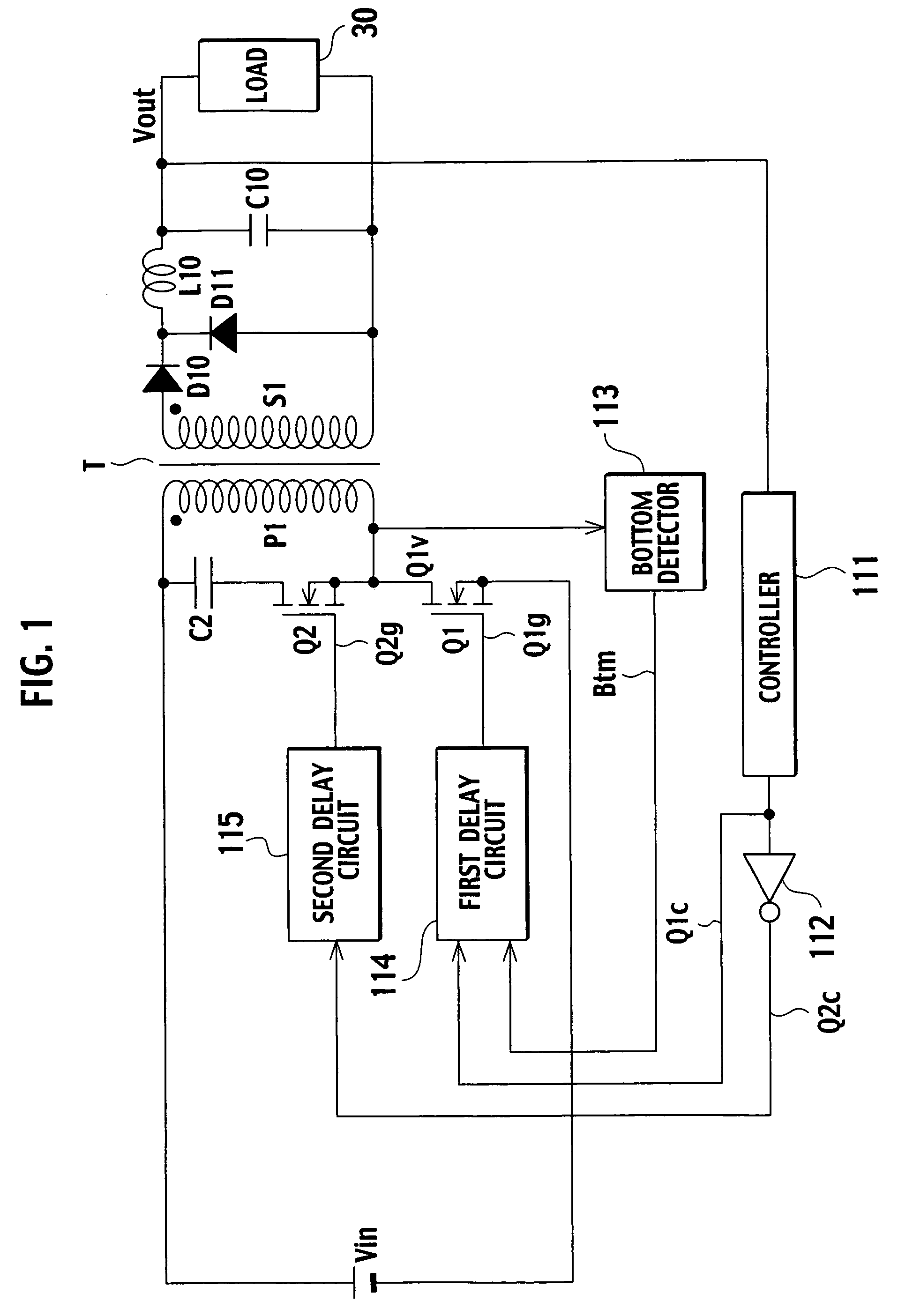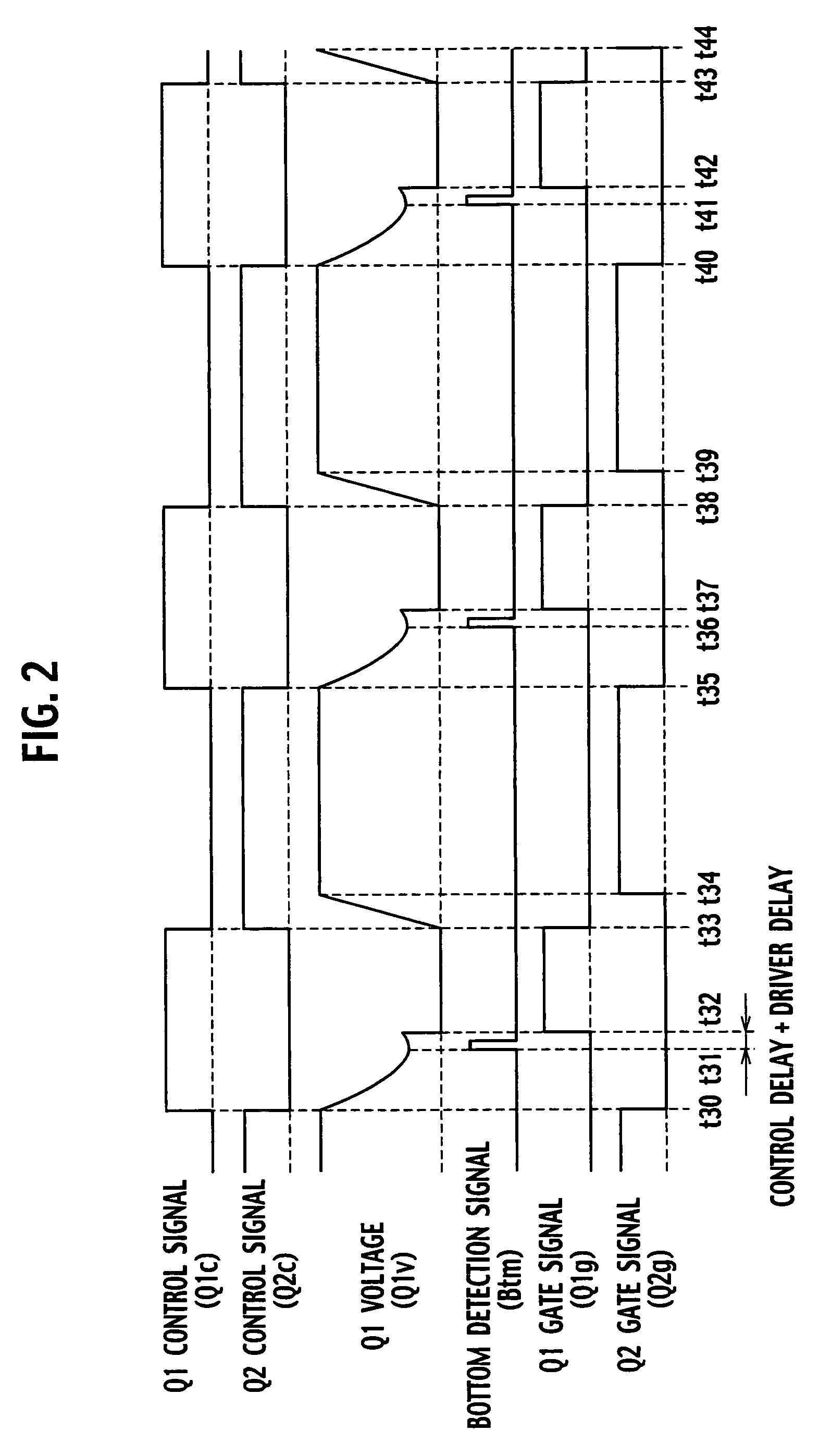DC converter
a dc converter and converter technology, applied in bridges, process and machine control, instruments, etc., can solve the problems of destabilizing the operation of dc converters and increasing switching noise, so as to reduce switching loss and noise, increase switching noise, and eliminate delay effects
- Summary
- Abstract
- Description
- Claims
- Application Information
AI Technical Summary
Benefits of technology
Problems solved by technology
Method used
Image
Examples
first embodiment
[0061]FIG. 4 is a circuit diagram showing a DC converter according to the first embodiment of the present invention. In FIG. 4, parts corresponding to those of FIG. 1 are represented with the same reference numerals.
[0062]In the DC converter of FIG. 4, a DC power source Vin is connected through a primary winding P1 of a transformer T to a main switch Q1 that is a FET. Ends of the primary winding P1 are connected to a series circuit including an auxiliary switch Q2 that is a FET and a clamp capacitor C2. The main switch Q1 and auxiliary switch Q2 have a dead time in which the switches Q1 and Q2 are OFF. The switches Q1 and Q2 are alternately turned on / off under PWM control carried out by a controller 11.
[0063]The primary winding P1 and a secondary winding S1 of the transformer are wound to generate in-phase voltages. The secondary winding S1 is connected to a rectifying / smoothing circuit 8, so that a voltage (on / off-controlled pulse voltage) induced on the secondary winding S1 is rec...
second embodiment
[0117]FIG. 20 is a circuit diagram showing a DC converter according to the second embodiment of the present invention. This DC converter includes a first time difference detector 13a and a second time difference detector 13b whose minimum voltage detecting sensitivity is lower than that of the first time difference detector 13a.
[0118]The first time difference detector 13a detects a time difference between a point around which a main switch Q1 provides a minimum voltage (bottom level) after an auxiliary switch Q2 turns off and a point when the main switch Q1 turns on, and provides a time difference detection signal Tdfa to an integrator 20. The second time difference detector 13b detects a time difference between a point around which the main switch Q1 provides a minimum voltage after the auxiliary switch Q2 turns off and a point when the main switch Q1 turns on, and provides a time difference detection signal Tdfb as a pulse-by-pulse control signal to a first delay circuit 14.
[0119...
third embodiment
[0131]FIG. 24 is a circuit diagram showing a DC converter according to the third embodiment of the present invention. The DC converter of the third embodiment includes a time difference detector 13 and a voltage change detector 22. Namely, the third embodiment employs the voltage change detector 22 instead of the second time difference detector 13b of FIG. 20.
[0132]The voltage change detector 22 detects a temporal change dV / dt in a voltage Q1v of a main switch Q1 and supplies a pulse-by-pulse control signal representative of the temporal change in the voltage Q1v to a first delay circuit 14. The first delay circuit 14 uses the output of an integrator 20 and the output of the voltage change detector 22 to delay a turn-on point of the main switch Q1. The first delay circuit 14 uses the output of the integrator 20 to minimize the output of the time difference detector 13. Based on the pulse-by-pulse control signal from the voltage change detector 22, the first delay circuit 14 controls...
PUM
 Login to View More
Login to View More Abstract
Description
Claims
Application Information
 Login to View More
Login to View More - R&D
- Intellectual Property
- Life Sciences
- Materials
- Tech Scout
- Unparalleled Data Quality
- Higher Quality Content
- 60% Fewer Hallucinations
Browse by: Latest US Patents, China's latest patents, Technical Efficacy Thesaurus, Application Domain, Technology Topic, Popular Technical Reports.
© 2025 PatSnap. All rights reserved.Legal|Privacy policy|Modern Slavery Act Transparency Statement|Sitemap|About US| Contact US: help@patsnap.com



